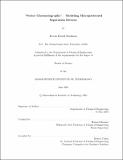| dc.contributor.advisor | Howard Brenner. | en_US |
| dc.contributor.author | Dorfman, Kevin David, 1977- | en_US |
| dc.contributor.other | Massachusetts Institute of Technology. Dept. of Chemical Engineering. | en_US |
| dc.date.accessioned | 2005-05-19T14:41:19Z | |
| dc.date.available | 2005-05-19T14:41:19Z | |
| dc.date.copyright | 2001 | en_US |
| dc.date.issued | 2001 | en_US |
| dc.identifier.uri | http://hdl.handle.net/1721.1/16812 | |
| dc.description | Thesis (S.M.)--Massachusetts Institute of Technology, Dept. of Chemical Engineering, 2001. | en_US |
| dc.description | Includes bibliographical references (leaves 72-73). | en_US |
| dc.description | This electronic version was submitted by the student author. The certified thesis is available in the Institute Archives and Special Collections. | en_US |
| dc.description.abstract | A repetitive sequence of quiescent fluid layers of differing viscosities through which small spherical Brownian particles move is analyzed so as to illustrate in a simple context how the theory of macro transport processes, a generalization of Taylor dispersion theory, may be employed to rigorously analyze spatially periodic micropatterned chromatographic separation devices for circumstances in which the solute species to be separated are animated by the action of species-specific external forces oriented asymmetrically relative to the body-fixed pattern. In the generic "vector" separation scheme, illustrated by our elementary example, the different species undergoing separation move, on average, in different directions relative to pattern-fixed axes, whence their chromatographic sorting is effected according to their different mean angular trajectories through the device. This scheme differs fundamentally from traditional "scalar" chromatographic separation schemes, wherein all species move on average parallel to the animating force (including circumstances in which they are passively entrained in a unidirectional solvent flow) and hence for which the sorting is effected by the relative speeds of the several species through the chromatographic column. Vector chromatography is quantified by two global "macrotransport coefficients," namely the solute mobility dyadic M* (representing the tensor proportionality coefficient between the mean solute velocity vector U* and the external force vector F acting upon the solute molecules) and the dispersivity dyadic D* (resulting from the deviation of the instantaneous position of the particle from its mean position based upon its mean velocity vector). In the present example these coefficients are studied parametrically as functions of: (i) the orientation of the external force relative to the symmetry axis of the fluid layers; (ii) the local viscosity distribution within a layer; (iii) the vector particle Peclet number (constructed from the vector force, the length of the viscosity period, and the Boltzmann factor kT); and (iv) the thermodynamic interphase solute partition distribution coefficient between the two fluid layers comprising a unit cell. | en_US |
| dc.description.statementofresponsibility | by Kevin David Dorfman. | en_US |
| dc.format.extent | 73 leaves | en_US |
| dc.format.extent | 1012395 bytes | |
| dc.format.extent | 1012153 bytes | |
| dc.format.mimetype | application/pdf | |
| dc.format.mimetype | application/pdf | |
| dc.language.iso | eng | en_US |
| dc.publisher | Massachusetts Institute of Technology | en_US |
| dc.rights | M.I.T. theses are protected by copyright. They may be viewed from this source for any purpose, but reproduction or distribution in any format is prohibited without written permission. See provided URL for inquiries about permission. | en_US |
| dc.rights.uri | http://dspace.mit.edu/handle/1721.1/7582 | |
| dc.subject | Chemical Engineering. | en_US |
| dc.title | "Vector chromatography" : modeling micropatterned separation devices | en_US |
| dc.type | Thesis | en_US |
| dc.description.degree | S.M. | en_US |
| dc.contributor.department | Massachusetts Institute of Technology. Department of Chemical Engineering | |
| dc.identifier.oclc | 50590434 | en_US |
